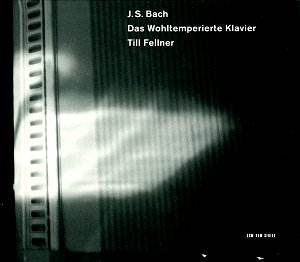I might as well state
my opinion that Bach’s Well Tempered
Clavier is the greatest body of music
ever created. It consists of two Books,
each having a series of twenty-four
preludes and fugues corresponding to
the twenty-four keys. This highly mathematical
and complex body of music is best thought
of as a logical entity. However, it
is also true that each prelude and fugue
well stands on its own, resulting in
ninety-six distinct pieces of music.
In addition to exploring
a wide array of musical structures through
the different keys, Bach also offers
us the full spectrum of the elements
of the human condition with all the
warts exposed. The Well Tempered Clavier
is a marvel of architecture and the
human spirit.
Till Fellner is entering
a field populated with exceptional piano
recordings from Richter, Tureck, Gould,
Aldwell, Gulda, Feinberg, Schiff and
Fischer. To the best of my knowledge,
this is Fellner’s first excursion on
record into the world of Bach, and he
has assumed a huge challenge. I am familiar
with the limited number of recordings
Fellner has made including Erato discs
of Beethoven Piano Concertos and Schubert
piano music, and I have found his performances
admirable without displacing favorite
versions.
How does Fellner convey
the world of Bach? His performances
exhibit a well-defined style informed
by lean textures of pristine quality,
rounded contours, subtle intensity,
and exceptional detail of inner voices
and the interplay among voices. Legato
phrasing is emphasized, and staccato
requirements are lightly applied. The
readings tend to be very warm and affectionate,
playing down some of the power and bite
in Bach’s music.
The warmth of Fellner’s
performances is shown to wonderful advantage
in many of the pieces and is best captured
in the Preludes in C major, C sharp
major, and B major. Fellner clearly
conveys his love of this music with
a glow that penetrates the listener.
The most compelling
aspect of Fellner’s interpretations
comes from the Bach fugues where one
can hear Bach dissecting the dark side
of the soul. These pieces, such as the
Fugues in D sharp minor, F minor, and
B flat minor, are quite bleak in outlook
with infrequent but heavenly rays of
light. Fellner plays this music superbly
with an incisive sense of inevitability
that rivals Gustav Leonhardt’s Bach
recordings. Also, Fellner is more lyrical
than Leonhardt, largely due to suppler
phrasing. After listening to Fellner,
I feel that the human condition has
been ‘sliced and diced’. His bleak and
severe presentations are riveting, making
Bach’s rays of light all the more stunning
and necessary to the musical progression.
I mentioned that Fellner
played down the music’s power and bite,
and it is the sole reservation I have
concerning the performances. In pieces
such as the Preludes in C minor and
A minor, Fellner can be rather subdued
and very much the opposite of the fiery
Gould and Richter. However, it is a
small blot on an impressive set of performances.
As for the soundstage,
it is well detailed and rich with a
little more reverberation than I find
ideal. Overall, the sound is excellent
and much preferred to the classic sets
of Gould, Tureck, and Gulda. The liner
notes are highly informative and insightful,
although there are a few errors in the
track listings. Given that Fellner is
not a famous pianist, one would think
that ECM would supply at least a couple
of paragraphs about the young man –
one would be wrong. Not a word of him
is mentioned, although there are two
photographs of him at the piano.
In summary, it is rare
to find Bach performances of the warm
and glowing variety (the "Papa
Bach" category) co-mingled with
striking portrayals of the underside
of the human condition. This is what
Till Fellner offers us, and only Rosalyn
Tureck in her Deutsche Grammophon set
is equally effective in providing this
particular mix of qualities.
In terms of additional
comparisons, Fellner sounds very much
like Keith Jarrett’s Bach at first blush.
However, further examination reveals
that Fellner’s rhythms are more elastic
than Jarrett’s, and Jarrett is light-years
removed from Fellner in conveying compelling
emotional themes. Another recording
of the Well Tempered Clavier that has
some strong similarity with Fellner’s
is Nonesuch set performed by Edward
Aldwell, but Aldwell’s textures are
much heavier.
Ultimately, I find
the Fellner set an essential acquisition
for Bach keyboard enthusiasts. I do
prefer the piano versions by Tureck
and Gould by a small margin, but those
recordings do show their age. There
is room at the top for an exceptional
modern set of performances, and Fellner
more than meets the high standards needed
to attain such a position in the Bach
discography. The set will receive serious
consideration as one of my Records of
theYear 2004, and I strongly urge readers
to consider its acquisition.
Don Satz


